
COURSEWORK
Week 10 - Cemre Yesil
I see my current practice as helping families to create individual art of loved ones.
My priorities include safety. I use a lot of props and also pose newborn babies.
For my practice to fulfill my client criteria, it usually involves creativity. Organising props, locations, costumes and sitters. Looking at the equipment too.
When I put all of this together along with post production techniques to enhance I then look at the medium I want to use to display it to its best. I want the experience to be pleasant and memorable for people.
If I am doing historical shoots we talk about history and the things that used to go on in those days, I ask my sitters how they think they would have felt in those days. So when the image is created they actually feel like they were a part of that era as they emotionally connected.
There is a lot more to what it takes to produce good art but you need to remain true to your responsibility, and loyal to your ethics which are the very first steps.
Without motivation and an understanding of your tools, I’m confident you can’t have good art. You will only have tourists and not owners
Week 10 Theory in Practice
Find an example of effective theory in practice. This could be an extract of text; a paragraph, sentence, or even just a phrase by a practitioner, theorist or commentator. Or it might be delivered in a different form, such as a talk or within a documentary. The content or subject is not of great importance, instead lookout for and consider why it is an effective piece of communication.
"Composition must be one of our constant preoccupations, but at the moment of shooting it can stem only from our intuition, for we are out to capture the fugitive moment, and all the interrelationships involved are on the move.”
Bair, N. (2016) ‘The decisive network: Producing henri cartier-bresson at mid-century’, History of Photography, 40(2), pp. 146–166. doi:
accessed April 17 2018
I am very guilty of trying for perfection, taking too long to find the right composition that often the shot is gone. Probably why I have stuck to indoor portraits in very controlled situations and not street photography.
"Composition cannot be planned, nor can it be added in afterwards. Cropping will invariably make a good shot worse and is unlikely to make a bad shot better. Camera settings shouldn't be something the photographer even thinks about – taking a photograph should be like changing gears in a car."
I need to learn to be better at finding reactive skills, and stop trying to be perfect.

Week 9 Critical Theory
Ketevan Kardava/Getty Images
I chose this image because it could be considered justified and also wrong.
The image itself is not a quality image, taken from an iphone in a moment of complete madness. When I saw this image my instant thought was poor woman, not only has she been involved in a bombing, ( I knew how that felt as I was caught up in the Paris bombings a few months before) I knew that feeling all over again. The person taking the picture, Kardava was at the airport when the bomb went off. Leaving Nidhi Chaphekar a flight attendant, shocked and stunned sat on the bench. One of my responses was poor woman, you can see the fear on her face, if she is still alive is going to have her boobs all over the media. Nidhi has to live knowing that she cannot hide from a distressing image of herself. The image then went on to go viral. The public needed to see. The person sat beside her seems disconnected from her, and so in that situation it may have been too shocking to see other people around you that need help.
The other point I was thinking, was how in times like that do you think to take a photograph of someone who is in obvious distress. Why at a time like that would you be thinking what image you can get from it and so I did judge the photographer along with a huge part of the population who condemned her for taking that image. The fact it did go viral did of course bring a lot of attention showing the fear and distruction that these terrosits bring to the front door. Should we display these images so they can sit back and admire their handiwork?
I don't think there is a right or wrong answer, depends what side of the fence you are on. Victim or photographer. But without images like these we would never see the devastation that envokes the sense of disgust to make us what to end these acts of terrorism. Images like these often used to incite hatred.
Micro Project week 7
My Brief this week was based on pychogeography and given to me by Gem.
The Brief
Think of a colour( run with the first colour that springs to mind) and go for a walk close to home. (Perhaps somewhere you've been many times, but consider taking a slightly different route than normal.)
Whilst you are out look for that colour and photograph upto 9 objects up close. (As close as you can)
Notice the details of the object and caption each one with one word to describe what you saw.
The first colour I thought of was red.
And then a moment of panic when I thought I am surrounded by green fields in the middle of winter.
Although psychogeography - loosely defined as how (predominantly urban) places or spaces can be used to effect or influence an individual’s psychological state - has been identified as a literary component in the fiction of Daniel Defoe and Robert Louis Stevenson, and is more commonly associated with the politically motivated Situationist movement and Guy Debord in Paris in the 1960s. Debord saw psychogeography as a means to disrupt the strictly managed urban environment, defined economically and socially, rather than emotionally or psychologically.
As Merlin Coverley summarises:
“Psychogeography is, according to Debord, a pure science, and like the skilled chemist, the psychogeographer is able both to identify and to distil the varied ambiances of the urban environment. Emotional zones that cannot be determined by architectural or economic conditions must be determined simply by following the aimless stroll (derive), the result of which may then form the basis of a new cartography characterised by a complete disregard for the traditional and habitual practices of the tourist.” (Merlin Coverley. Psychogeography. p.90)




Oral Presentation - week six
Conduct and record a reflective presentation on your current photographic practice. Your presentation should critically examine the motivations and objectives behind your work to date. You should also discuss your plans for your research project, and explain how it will extend from your current practice.
Towards an ethical practice - week five
The task was. Write a brief statement, or ‘manifesto’ that defines your purpose as a photographer. Consider:
-
What are your responsibilities?
-
Who are you answerable to?
-
Who should answer to you as an image maker?
My responsibilities are foremost to be true to myself. To progress with creativity.
To be creative is to shoot with purpose and vision, and that involves conscious manipulation of the real life situation like my choice of kit, settings, light, perspective, composition, and post processing the image to capture the mood or story I envision when planning to take an image. Creativity is challenging myself to think differently in an effort to create art.
To create art that will stand the test of time like our paintings of the past. As a creative art producer I am mostly answerable to myself. However when working to a brief I become answerable to the person paying the invoice. As an overall image maker I should be answerable to and justify my images to whom ever is seeing them. The people that should answer to me are any collaborators I choose to use to help me create my final piece, from costume to printers.
To be honest and act with integrity

© Gail Timms
Collaboration




The activity this week was to identify one or two questions or challenges that citizen journalism and its related aesthetics raise, and critically articulate your own conclusions.
Privacy I feel is one of the challenges that citizen journalism is making unimportant but has a double edged sword as lack of privacy helps track criminals. Journalism has always been about the story, regardless of who it hurts along the way. But with the year of digital, the speed that images and video is now public doesn't give any time to think about consequences or even filter what is appropriate. Especially with the way the youth have access to the web, they see things, film it and post on Instagram, facebook or Twitter, whats Ap, not forgetting snapchat without even thinking. Often having a knock on effect that it is more likely to be used by a criminal, a bully or abusers and they are often caught out as they are on the web and it is easy to share stories to find a person. Regardless of how as a parent you try and protect, it is pretty much impossible even with restrictions in place. With the rise of social media and smartphones, teenagers are increasingly filming and distributing footage of their attacks online in attempts to intimidate rivals and increase their own credibility. Vulnerable children sharing private sexual images while being groomed online, it was bad enough before the iPhone, apparently the best way to deal with this is to educate children to make right choices, who knows many kids that make the right choice when they really have no idea of the consequences or long term effects? It's okay having these advances in technology but what about the next generations safety.
The era of citizen journalism has help bring incidents to your doorstep, often as things happen and not just images of the after effects. Incidents like the Tsunami, comes to mind as I was there in Sri Lanka two weeks before and so it was close to home. Without people filming, none of us would experience what those people did. Journalists where hassling people at the airports for their phones to check footage and paying for it. Has the age of digital made us uncaring in the desire to get the most shocking or snuff images? I almost see us becoming like the culture I saw in China where by people walk past injured people or a baby in the gutter, nothing shocks any more.
There are so many soldiers with ptsd due to what they have seen and yet our children are exposed to this daily via the web, is it any surprise so many kids are messed up these days or that youth crime is increasing? The use of the phones to film deaths for a political cause, is it any surprise so many kids are messed up these days seeing it and want to emulate it into their gangs. Then spread the 'snuff" around the web for the world to see to damage some more people.
So as much as I can see some gorgeous images people have taken with digital and even added a lovely vintage filter. I think it is one of the worst un controllable progressions we have had.
-
I am thinking of another problem Gail, as the rise of technology is fulfilling individual’s goal or intention, it is simultaneously helping grow crimes specially cybercrimes. A citizen can now easily document an event if it happens before them, they can spread it through social media, and mainstream media can buy the content too but in many cases we have seen in the war zone many amateur photojournalists had risked their lives to take photos even who don’t have proper combat training and their images were being used in the media. Who will be responsible then? To earn some extra money, people did it even children did take photos.
-
Gail, I quite agree that privacy has unfortunately become a thing of the past. And it is not only the ubiquity of Smartphones, but the proliferation of security cameras, tracking software etc, etc, etc. We are watched and recorded far more than we realize and I know I haven't signed an informed consent form. I am afraid that horse is well out of the barn and never coming back.
I am concerned about the ethics and scruples primarily of the publishers. As others have noted "dishing the dirt" sells and because a photograph is a record of only fraction of a moment in time, the images are so easily taken out of context. It seems to me that certain outlet make their business out of taking things out of context or using that one embarrassing moment. Greed and personal gain seem increasingly to outweigh civility and social responsibility, often under the banner of "truth", but is it really truth?
Used responsibly it can be powerful as the images from students inside the Florida school this week during the shooting were. It clearly gives us a view into something we would have otherwise had none.
So the forum task this week was...Write a brief post to the forum describing what you think non-photographers make of professional photographers: what are the conceptions and misconceptions and my tuppence worth was...
Well to be honest I feel in 2018, everyone is a photographer so it would be hard to find a person who doesn't take lots of images on Iphones and compacts so I don't think non photographers really exist, well not in the UK anyway. That said I have seen some amazing shots from non professionals or hobbyists, those people who just love to take a shot of the flora and fauna in their yard and some unforgivably poor images from so called professionals.
You could argue that the essence of a true professional photographer is having the ability to deliver brilliant photographs anytime, anywhere in any situation. But again, there many professionals who can’t do that and are one genre photographers…also there a ton of hobbyists who can rise to that challenge in any genre each and every time.
So, I think when you think about the level of ability to create amazing photographs consistently, and then add the skill to earn income from it if they so choose, as well as being able to deliver under pressure like at a wedding or a key moment then you start to get to the base of what a professional photographer should be. Does that mean they are better? Should it not be based on the skill with the equipment, at the time of the image or post processing that makes the final beautiful product. So I don't really like the term professional, I believe you are either skilled or not. People don't tend to search pro photographer, they search for example Newborn Photographer. So I think the term pro is given to themselves in their desire to be seen as competent in the art form.
I know very unskilled photographers calling themselves pro, who outsource editing to skilled editors, making the image taker look better than they are. I don't believe it should be based on what comes out of the camera but what you present the client.
For example " Photo manipulation dates back to some of the earliest photographs captured on glass (Links to an external site.)Links to an external site. and tin plates (Links to an external site.)Links to an external site. during the 19th century (Links to an external site.)Links to an external site.. The practice began not long after the creation of the first photograph (1825) by Joseph Nicéphore Niépce (Links to an external site.)Links to an external site. who developed heliography (Links to an external site.)Links to an external site. and made the first photographic print from a photoengraved printing plate. Traditional photographic prints can be altered using various methods and techniques that involve manipulation directly to the print, such as retouching with ink, paint, airbrushing (Links to an external site.)Links to an external site., or scratching Polaroids (Links to an external site.)Links to an external site. during developing. Negatives can be manipulated while still in the camera using double-exposure techniques, or in the darkroom (Links to an external site.)Links to an external site. by piecing photos or negatives together. Some darkroom manipulations involved techniques such as bleaching to artfully lighten or totally wash-out parts of the photograph, or hand colouring for aesthetic purposes or to mimic a fine art painting." Link (Links to an external site.)Links to an external site. to Wiki
Does a pro mean ability to make money, or an ability to produce a great shot?
Personally I think it is the ability to meet a brief.
I asked a few friends who do not use dlsr cameras and just phones for images, and they pretty much describe a "professional photographer' as someone who is skilled in the art of photography including how to pose, how to light, composition and comes up trumps each time when they ask for a job to be done, no real mention of money and if there is it is usually over priced..
The term pro, is it the difference between good and bad? You dont hear of a teacher and pro teacher.
The subject made me think very hard about how even my non photographer friends see me and it is something I am going to ask them.
On the forum Mick replied with
"Gail, that's a hugely thoughtful post, and pretty easy to agree with most of it. I totally agree about "the ability to meet a brief". I also like your last line 'You don't hear of a teacher and pro teacher'.
I also know seem hugely skilful photographers who are not 'pros' and 'pros' that are rather 'one trick ponies'.
That said, I do think there is a distinction between someone who does something for a living, and someone who doesn't - in all careers, not just photography. I teach, and what I do is I think fairly well regarded. But it's not my profession :-)"
I agree there is a distinction but feel that just because someone does something paid full time, doesn't make them professional in the sense of having a higher skill level.
With it being the anniversary of the Suffragettes, what better time than to look at them in a different way.

With the Suffragettes being big in the news 100yrs. I thought I’d think about them in relation to Photography and criminal activity albeit a very strong unified discipline and the Police force developing photography as a discipline to identity criminal activity.
Its is very common practice for Police to stake out a crime, hiding in vans and bushes. CCTV everywhere you look, concerts and large events and always eyes on our social media. Not many people knew that the act of covert surveillance was developed by Scotland yard to try and manage and stop the direct acts from the Suffragette movement of women fighting for rights. Police developed the affectionately known ”Mug shots” in 1914 of the Eighteen women who was sentenced to prison for the cause. It also shows that it was the Police responsible for the snatch and grab methods of the modern day Journalists. Most of the images where Paparazzi style as the time it took to take a photograph meant the moment or person was often gone. So many photographs are a very poor form of identification, many with the women distorting the face to prevent identification. None the less the predecessor to todays identity methods.

Images of women chaining themselves to railings, having violent clashes with police. Files found include the image of Evelyn Manesta, no 10 she was arrested and had a photograph taken with a prison guards arm around her neck as she refused to have her photograph taken normally. The photograph was then altered as it caused outrage as it demonstrated the brutality the women went through.
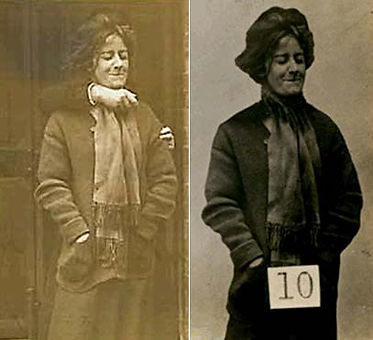
The Mugshots came in to Play when they tried to identity the woman who broke into the national gallery and took a meat chopper to paintings of naked women.
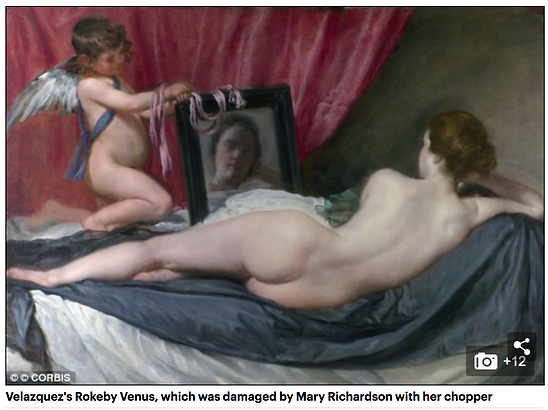

So not only did the women get rights for women, they developed the skills of Police even if it wasnt conciously.
Mulcahy, Linda (2015) Docile suffragettes? Resistance to police photography and the possibility of object–subject transformation. Feminist Legal Studies, 23 (1). pp. 79-99. ISSN 0966-3622
I think other students were surprised and interested about the mugshots information
Edward Staines said.
"I found this subject really interesting Gail. We almost forget today how the authorities track us with video and photography with CCTV, traffic cameras, border security and facial recognition and even hyperspectral imaging (though this has other uses beyond surveillance).
As an aside, Velaszquez's Venus has a particular significance for me. In 1986 on a school art history trip to see Francis Bacon's Tate exhibition, a friend and I bunked off to the National Gallery (how reckless were we?!), and there in front of the Venus was Franics Bacon. We chatted for quite a while, discussing art and artists, and he even signed the brochure for his Tate Exhibition, which I still have.
My art teacher never forgave me..."
Mick Yates said.
"Gail, a real eye opener ... thank you! I did not know the suffragette story around mugshots at all.
A colleague of mine, Kevin MacNish, then in the Leeds University Interdisciplinary Ethics Centre wrote an excellent book on the Ethics of Surveillance, published last year.
Kevin is now Assistant Professor of Philosophy at the University of Twente, Netherlands."
and went into discussion about how the debate of Cctv and the eye on you was a great debate .
So the brief was"Take a picture from your widow and share it with your peers on this forum. It might be a window from where your work, or somewhere else in your home. Think about what this might say about you - your situation; your photography; or your interests more generally. Don't labour this task - it's just a way to introduce yourself to your peers"
I had a whole knew meaning to the world labour. I made this task much harder than it was purely through the fact I didnt realise that everyone would be seeing something else. I live in very flat Lincolnshire, as rural as it gets and a very boring view from all aspects. Until my horses walked into shot I felt now was the time.
It was purely a way to introduce ourselves and break the ice. But it did more than that. It showed me that we all have different out looks and very different opinions on what was expected. I was not the only one who found this hard which reassured me. It opened up the can of worms, called The Global Image.
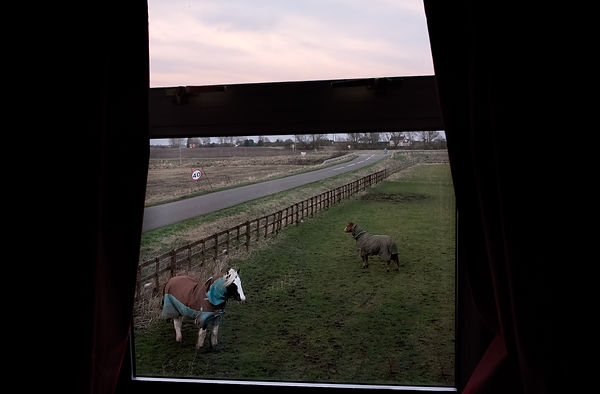
Gary McLeod commented on the lines which I hadnt noticed before he commented.
©Gail Timms
"Welcome aboard Gail. The more I look at this, the more I appreciate the quirky quality of the lines. The horses then begin to look like your collaborators. Do you photograph them much?"
No I don't but that will change I am sure during this course.
This brief was; re-make' an image of your choice. You may wish to re-make an image from one of the presentations, or a completely different image of your choice.
You are free to be pessimistic or poetic; playful or profound... however, your re-make should relate in some way to the theme of the global image.
So here began my over thinking again! But I eventually came up with "The Crying Boy" By G Bragolin. I am a very emotive photographer which is why I tend to use children a lot as they are very expressive, if challenging to work with. So my image I remade was this little cutie.

© G Bragolin The Crying boy
© Gail Timms one
So contacted my Daughter and asked if my grandson would model for me, he is very used to being my muse. so happily accepted the challenge. This was the end result.

© Gail Timms The Crying boy
This inspired me further to the degree that I decided I am going to do a series of crying children.
We then had to present these in a webinar, that in itself was very different to me. I put my brave pants on though as offered to go first. I was a little emotional describing how the children in the painting where from orphanages in Venice, It brought a whole new meaning to the paintings which I enjoyed sharing.
Whilst I was researching this, I questioned the morality of this and wondered how moral it actually was and how did they see the children crying? Did they tease, scare them? I read that many images where actually tears added but I think the artist could see inside the children and could see that just by the fact they where in an orphanage they must be very sad inside.
During the webinar Gary, asked "what happened to the children? Did they actually see their painting" Something I have thought about a lot since as I always make a point of my models having copies of images I have taken, something maybe not possible when it is a one off painting. These painting became mass produced so chances are high some of them may have seen themselves.
Because of my thoughts around how did they make the kids cry, I wondered if the other students would have thought the same way and so I showed the image taken a couple of seconds before, having fun with his Mother squirting water.
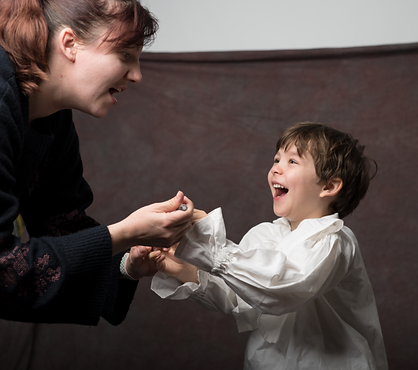
© Gail Timms The Crying re made
This then changed the emotion of the webinar, especially when Gary said "I actually think I wished i hadnt seen this" He liked being in the moment of the upset child and almost like a balloon popping moment, taken away by the process to achieve it.
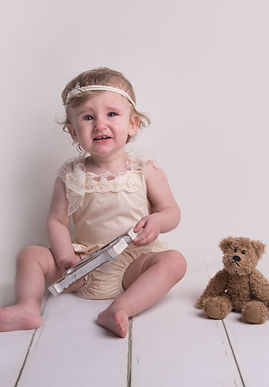


© Gail Timms TheLittle Prince
© Gail Timms Oh Lilly
Week 1 Webinar: The Global Image and Your Practice
In addition to your re-make of the global image that you made this week, select up to three of your own images, or pieces of your own work, you feel relate to this week's theme.
During the webinar you will take it in turns to present your work (the re-make and your own images), articulate your ideas, and receive feedback and comments from your Tutor and your peers.
I tried to demonstrate that it is very easy and very common for children to cry during studio sessions.




